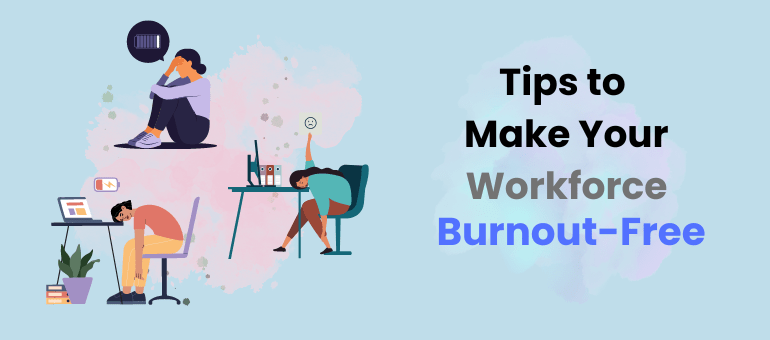Burnout is a common problem in the workplace, and it can have serious consequences for both employees and employers. It is a significant problem with potential long-term effects on employees and businesses. Burnout happens when a worker becomes overwhelmed, worn out, or uninspired due to ongoing stress at work. Therefore, it’s critical to recognize the symptoms of burnout so that it may be treated before things get out of hand.
Fortunately, you can combat it effectively by establishing clear boundaries. This blog post will explore tips to help make your team more resilient against burnout.
What is Employee Burnout?
Employee burnout is a state of emotional, mental, and physical exhaustion caused by extreme and prolonged stress. It may arise or occur when an employee feels overwhelmed or unable to match the demands of their job. Burnout can lead to decreased productivity, increased absenteeism, higher turnover rates, and even health problems such as depression and anxiety.
Burnout often results from working in an environment with high expectations but offering little support or recognition for employees’ efforts. Common causes include:
- long hours with no breaks
- lack of control over one’s work
- unclear goals or objectives
- too much responsibility without sufficient resources
- inadequate compensation for effort expended
- poor communication between management and staff members
- unrealistic deadlines set by supervisors
- unsupportive colleagues or superiors who are unwilling to help out when needed.
Typical Signs of Employee Burnout
Employee burnout is a serious issue that can have long-term consequences for employees and employers. It’s important to be aware of the signs of employee burnout so you can address it before it becomes too severe.
Employees experiencing burnout
- may feel exhausted most of the time,
- have difficulty concentrating on tasks at hand,
- become cynical about their job duties,
- lose motivation to complete projects successfully,
- and experience feelings of detachment from coworkers/employers/clients, etc.
- Suffer from insomnia due to worrying about work-related issues during off hours.
Common symptoms of employee burnout include:
- Decreased motivation or enthusiasm: Employees may become apathetic towards their work, lack energy, and show less interest in tasks they once found enjoyable.
- Increased absenteeism: Burned-out employees are more likely to call in sick or miss days due to exhaustion.
- Poor performance: Burned-out employees often struggle with productivity and quality control as they find it difficult to focus on the tasks.
- Low morale: Employee morale tends to suffer when people feel overworked and underappreciated, making them irritable or withdrawn from colleagues.
- Physical health issues: Stress caused by burnout can manifest through physical ailments such as headaches, fatigue, insomnia, digestive problems, etc.
If you notice any of these signs among your team members, it’s time for action! Make sure everyone has access to mental health resources like counseling services, provide flexible working hours, and encourage regular breaks throughout the day. Additionally, ensure workloads are manageable, recognize achievements regularly, promote healthy lifestyle habits like exercise and proper nutrition, and create an open dialogue about stress levels within the workplace environment. These are just some ways you can help prevent employee burnout from occurring in your organization.
Most Common Causes of Employee Burnout
When there are no clear goals or objectives set out by management, employees may become confused about what they should be doing and how their work fits into the bigger picture. This lack of clarity can lead to frustration and burnout if not addressed quickly.
Additionally, employees need to feel appreciated for their hard work to stay motivated and engaged with their job over time. If they don’t receive any feedback or rewards from management regularly, this could cause them to lose interest in their role, leading to apathy and eventual burnout.
Furthermore, working excessive hours without proper breaks will take its toll on even the most dedicated worker after some time passes by. Allowing your team members adequate rest periods throughout the day is essential for avoiding fatigue-related issues such as exhaustion and, ultimately, burnout down the line.
Finally, miscommunication between departments or within teams can create confusion among staff members. This can make them feel frustrated with unclear instructions given by superiors. This often results in low morale levels, leading to increased risk factors associated with employee burnout syndrome.
#1 Tip – Prioritize Wellbeing Initiatives
Investing in wellbeing initiatives such as providing access to mental health resources or offering flexible working hours shows that you care about employee wellbeing beyond just productivity metrics – something that goes a long way towards preventing burnout in the first place!
#2 Tip – Establish Clear Boundaries
Workers need to know what their job entails, so they don’t feel overwhelmed or overworked. Setting clear boundaries around tasks and expectations helps ensure everyone knows exactly what needs to be done without feeling like they’re taking on too much work at once.
#3 Tip – Encourage Breaks and Vacations
Taking regular breaks throughout the day, as well as taking vacations when needed, can help reduce burnout in your workforce. Allow employees to take time off for mental health days or vacations without feeling guilty.
#4 Tip – Foster Open Communication
Creating an open dialogue between managers and employees ensures issues or concerns are addressed quickly before they become bigger problems. This communication should include feedback loops where managers provide constructive criticism and praise when appropriate, which go a long way towards keeping morale high within teams!
#5 Tip – Promote Flexible Schedules
Offering flexible schedules allows employees to work at their own pace and manage their workloads more effectively while meeting deadlines. This helps them avoid overworking themselves and burning out quickly.
#6 Tip – Foster a Positive Working Environment
Creating an environment that supports employee wellbeing will go a long way toward preventing burnout among your staff members. Provide resources such as counseling services or stress management classes, if possible, so they have access to support whenever they need it most.
#7 Tip – Set Clear Expectations
Setting clear expectations will ensure that everyone knows what’s expected of them and how much effort needs to be put into each task assigned by you or other team leaders within the organization. This prevents confusion and frustration, both common causes of burnout in the workplace.
In Conclusion
Avoiding burnout in your workforce starts with creating an environment where employees feel supported, respected, and encouraged to care for themselves mentally and physically. You can make this happen through breaks, vacations, flexible schedules, positive working environments, and clear expectations.
To prevent burnout, it is important for employers to create a supportive workplace culture where employees feel valued and appreciated for their contributions while also having access to adequate resources (time off/flexible schedules) so they don’t become overly stressed out trying to complete assigned tasks within tight timelines.



